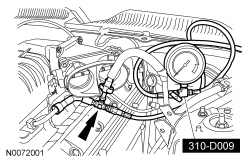
310-D009 (D95L-7211A) or equivalent
SECTION 310-00: Fuel System — General Information
| 2014 Mustang Workshop Manual
|
GENERAL PROCEDURES
| Procedure revision date: 01/07/2013
|
 | Fuel Pressure Test Kit
310-D009 (D95L-7211A) or equivalent |
 WARNING: Do not smoke, carry lighted tobacco or have an open flame of any type when working on or near any fuel-related component. Highly flammable mixtures are always present and may be ignited. Failure to follow these instructions may result in serious personal injury.
WARNING: Do not smoke, carry lighted tobacco or have an open flame of any type when working on or near any fuel-related component. Highly flammable mixtures are always present and may be ignited. Failure to follow these instructions may result in serious personal injury.
 WARNING: Do not carry personal electronic devices such as cell phones, pagers or audio equipment of any type when working on or near any fuel-related component. Highly flammable mixtures are always present and may be ignited. Failure to follow these instructions may result in serious personal injury.
WARNING: Do not carry personal electronic devices such as cell phones, pagers or audio equipment of any type when working on or near any fuel-related component. Highly flammable mixtures are always present and may be ignited. Failure to follow these instructions may result in serious personal injury.
 WARNING: Before working on or disconnecting any of the fuel tubes or fuel system components, relieve the fuel system pressure to prevent accidental spraying of fuel. Fuel in the fuel system remains under high pressure, even when the engine is not running. Failure to follow this instruction may result in serious personal injury.
WARNING: Before working on or disconnecting any of the fuel tubes or fuel system components, relieve the fuel system pressure to prevent accidental spraying of fuel. Fuel in the fuel system remains under high pressure, even when the engine is not running. Failure to follow this instruction may result in serious personal injury.
 WARNING: Always disconnect the battery ground cable at the battery when working on an evaporative emission (EVAP) system or fuel-related component. Highly flammable mixtures are always present and may be ignited. Failure to follow these instructions may result in serious personal injury.
WARNING: Always disconnect the battery ground cable at the battery when working on an evaporative emission (EVAP) system or fuel-related component. Highly flammable mixtures are always present and may be ignited. Failure to follow these instructions may result in serious personal injury.
 WARNING: When handling fuel, always observe fuel handling precautions and be prepared in the event of fuel spillage. Spilled fuel may be ignited by hot vehicle components or other ignition sources. Failure to follow these instructions may result in serious personal injury.
WARNING: When handling fuel, always observe fuel handling precautions and be prepared in the event of fuel spillage. Spilled fuel may be ignited by hot vehicle components or other ignition sources. Failure to follow these instructions may result in serious personal injury.
All vehicles
3.7L and 5.0L (4V) vehicles
5.8L (4V) vehicles
NOTE: Use a commercially available fuel test adapter (such as OTC® 18527).
Install the Fuel Pressure Test Kit and the fuel test adapter between the fuel jumper tube and the fuel rail.
All vehicles
NOTE: The Fuel Pump Control Module (FPCM) was previously disconnected in the Fuel System Pressure Release and must be reconnected to complete the Fuel System Pressure Test.
Connect the Fuel Pump Control Module (FPCM) electrical connector(s).NOTE: It may take more than one key cycle to pressurize the fuel system.
Cycle the ignition key and wait 3 seconds to pressurize the fuel system. Check for leaks before starting the engine.NOTE: After completing the fuel system pressure test, open the drain valve on the Fuel Pressure Test Kit and release any residual fuel into a suitable container prior to removing the tool.
Test the fuel system pressure to make sure it is within the specified range. For additional information, refer to Specifications in this section.